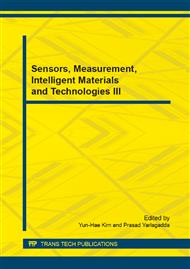[1]
Wei, S. Study on parameter setting of excitation system. Chinese Society for Electrical Engineering, 2002, 10, 13-18.
Google Scholar
[2]
Fang, S.L. The calculating method of excitation system ceiling voltage and voltage response ratio of large generator. Electric Power, 1984, 4, 56-60.
Google Scholar
[3]
Zhao, H. G; Liu, Z.H. Research on mathematical models and parameters of generator excitation system and governor system for stability analysis of interconnection of central china power grid with Sichuan-Chongqing power grid. Power System Technology, 2005, 5, 50-57.
Google Scholar
[4]
Mahmud, M. A.; Pota, H. R.; Hossain, M. J. Full-order nonlinear observer-based excitation controller design for interconnected power systems via exact linearization approach. International Journal of Electrical Power & Energy Systems, 2012, 41, 54-62.
DOI: 10.1016/j.ijepes.2012.03.007
Google Scholar
[5]
Dou, C.X.; Zhang, X.Z.; Guo, S.L. Delay-independent excitation control for uncertain large power systems using wide-area measurement signals. International Journal of Electrical Power & Energy Systems. 2010, 32, 210-217.
DOI: 10.1016/j.ijepes.2009.07.008
Google Scholar
[6]
Jonaitis, A.; Daunoras, J. Identification of dynamic model of synchronous generator high frequency excitation system.Electronical Electronic. 2011, 1, 25-28.
Google Scholar
[7]
Wan, S.P. Survey on intuitionistic fuzzy multi-attribute decision making approach. Control and Decision, 2010, 25, 1601-1606.
Google Scholar
[8]
Gong, Y.B.; Ding, D. C; He, J.M. Multi-attribute decision making method based on similarity measures of intuitionistic fuzzy sets. Control and Decision, 2009, 24, 1398-1401.
Google Scholar
[9]
Wang, J.Q.; Zhang, H.Y. Multicriteria decision-making approach based on atanassov's intuitionistic fuzzy sets with incomplete certain information on weights. IEEE Transactions on Fuzzy Systems, 2013, 21, 510-515.
DOI: 10.1109/tfuzz.2012.2210427
Google Scholar
[10]
Xu, Z.S. Intuitionistic fuzzy multiattribute decision making: an interactive method. IEEE Transactions on Fuzzy Systems, 2012, 20, 514-525.
DOI: 10.1109/tfuzz.2011.2177466
Google Scholar
[11]
Huang, Y.C.; Ruan, L.; Ruan, J.J. Evaluation on intelligent renovation of substations based on improved TOPSIS. Power System Technology, 2012, 36, 42-48.
Google Scholar
[12]
Yu, Y.; Liang, L. Extensions of the TOPSIS for multiple criteria decision making. Systems Engineering, 2003, 02, 98-101.
Google Scholar
[13]
Yang, G.C. The principle of power system automation equipment, China Electric Power Press, (2007).
Google Scholar
[14]
G18 GB_T7409. 3-2007, Excitation system for synchronous electrical machine–technical requirements of excitation system for large and medium synchronous generators.
Google Scholar
[15]
DL/T1167-2012, Guide for modeling generator excitation system.
Google Scholar


